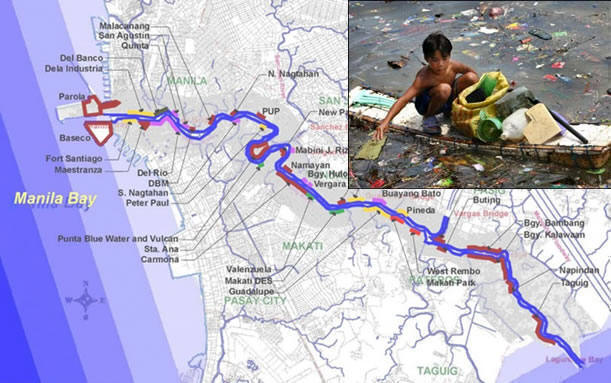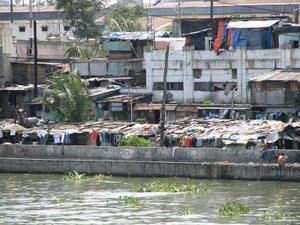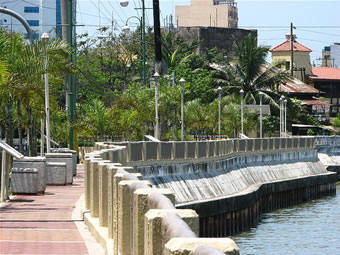|
The muddy waters
of Pasig River

In
his novel El Filibusterismo
José Rizal describes how a captain navigates his old and ponderous
steamer Tabo on the Pasig River to the Laguna Bay. The river
meandered and the narrow fairway was marked by wood stakes only
insufficiently. Sandbanks blocked the way of the river again and
again. The Pasig is not yet canalized and has no bank reinforcement.
It "glitters in the morning sunlight". Little carpets of water
lilies are slowly drifting down the river. The Pasig is rich in
fish, many fish traps are laid out. Mangroves and bamboo bushes line
the banks. Bathing people enjoy themselves in the river, often they
can still see the bottom of the river. And let us hope that they did
not meet one of the crocodiles which are still shall in the river
and adjacent Laguna sea. The quality of water plays already an
important role. When in 1820 a Cholera epidemic broke
out, foreigners are accused to have poisoned the Pasig. Some of them
are massacred. The water of the river was regarded as sacrosanct.
There are various speculations over the
origin of the river name "Pasig". Some say it derives from the Tagalog
and stands for sandbank.
Others suspect that the name could be a spoonerism of the name of
Legaspi, the first Spanish general governor. Already before the arrival of
Spanish colonizers when Manila was still ruled over by Still was
ruled over by Muslim Rajahs - the Pasig was an important traffic
route on which goods and persons were transported.
Let's
add some data about the river itself. The Pasig is only about
25 km long and connects the Manila Bay with the Laguna lake.
The Laguna Bay with its 922
km2
(almost the double of the area of Lake Constance) is one of the
biggest freshwater lakes of Southeast Asia and has an average depth
of water of only round about two metres. Into which direction the
rivers flows depends on the water level of the sea in the Manila Bay
and such of the Laguna Bay. It varies seasonal. If the water-level of the Laguna
lake sinks in the dry season (March - May) and high saltwater floods
of the Manila Bay press in the Pasig then the water can stand or
even can flow backwards. The fishermen of the Laguna Lake are
ascribing positive effects to the saltwater influx into the Laguna
Lake and they argued therefore against the erection of a dam between
river and the lake.
Nowadays the river is between 120
(Manila Bay mouth) and 60 metres wide and four to six metres deep.
It flows through a densely populated area.
It is estimated that actual approx. 4.4 million of the 15 million
people in Manila are living on or nearby the river and his 13
tributaries (2).
The river system of the Pasig passes in the area of Manila eight
towns and three larger communities. North of the river are e.g. the villages of Binando,
Quiapo, Sampalag, San Miguel, Santa Cruz, Santa Mesa and Tondo, in
southern direction we can find among others Ermita, Intramuros,
Malate, Paco, Pandacan, Port Area, San Andres, Bukid and Sta. Anna.
Again back for the history of the
river. At the end of the 19th
century the port of Manila was extended further and the Pasig
canalized. The canalization enabled
a safer and more economic
use of the waterway to the Laguna Bay. Then the
first four big bridges over the were built. Today eight bridges span
over the Pasig in Manila. It
was chic to live and to promenade at the banks of Pasig. The rich had their houses near the
river and the presidential palace Malacanang was also built near the
Pasig.
A little bit
too flamboyantly
the
river was compared with the "Canale Grande" of Venice.
Later
the industrialization starts and more and more factories were
settled at the waterfront. Today the
number of factories is round about 300.
The water quality of the Pasig
begins to worsen. The fish
populations decline in the thirties and warnings are issued not to
bath in the river. A decade later laundry is practically not more
washed in the river. The
river begins to stink.
Instead of water lilies now more more coloured plastic bags with
waste could be seen swimming on the surface. The business activities
shift more and more to Makati, the richer persons are looking for
new attractive residential areas. The riverside region loses housing
quality. Now the "Canale
Grande" has become a sewer.
The water pollution comes mainly from domestic and industrial
sources. According to a newer UNO
report of 2006 150 tons of domestic solid and liquid waste and 75
tons of industrial waste are dumped into the Pasig daily -
that's about 82,000 tons waste a year
(3).
Pollution from leachate because of bad sanitation and sewerage
cannot be measured exactly but has enormous dimensions. Especially
the squatter colonies lined at the banks the river became a
target of criticism.
 The squatters are sometimes also
called - less discriminatory - "Informal Settlers" or "Urban Poors".
As of the sixties they began to settle at the river banks in
increasing number. They left their impoverished homes in the
provinces in the hope Manila would offer them more better earnings.
Mostly they settle on public ground without any permission or
renting contract. They live
in very modest quonsets with plywood walls and without connection to
the waterworks systems. The huts are often standing on
stilts because in the rainy season the Pasig frequently bursts its
banks. The number of
the squatters on the Pasig is not constant and can only be
estimated. In 2000 it was supposed that round about
60,000 families are directly living at the river banks. That
correspondents to 300.000 persons, if we assume five persons in a
average family(4).
In his profound article on the squatters Moritz Kleine-Brockhoff even reckons
the number of river-residents
at 350,000(5). If we follow this author, almost a
third of the population of Metro Manila can be classified as
squatters. The squatters are sometimes also
called - less discriminatory - "Informal Settlers" or "Urban Poors".
As of the sixties they began to settle at the river banks in
increasing number. They left their impoverished homes in the
provinces in the hope Manila would offer them more better earnings.
Mostly they settle on public ground without any permission or
renting contract. They live
in very modest quonsets with plywood walls and without connection to
the waterworks systems. The huts are often standing on
stilts because in the rainy season the Pasig frequently bursts its
banks. The number of
the squatters on the Pasig is not constant and can only be
estimated. In 2000 it was supposed that round about
60,000 families are directly living at the river banks. That
correspondents to 300.000 persons, if we assume five persons in a
average family(4).
In his profound article on the squatters Moritz Kleine-Brockhoff even reckons
the number of river-residents
at 350,000(5). If we follow this author, almost a
third of the population of Metro Manila can be classified as
squatters.
Since the squatter families do not
connections to the main water supply, they have to look if there is
a public water installation or faucet, have to tap a water pipe
illegally or they have to buy drinking water, which can be
expensive. And where to go with the domestic waste, if there is no
garbage collection or a sewage system? One possibility could
be to deposit it secretly in the
neighbourhood area. However, the more direct and faster way leads to the Pasig river,
which then becomes a substitute sewer. There is
another
estimate after which the Pasig-Squatters transfer
daily approximately 35 tons solid and 150 tons liquid waste
into the river
(6).
In connection with this we
should mention that the sewer system in Manila
is one of the poorest in South East Asia. More than 11 million inhabitants of
Metro Manila (approximately 85%) do not have proper access to
sewerage facilities according to the Environmental Management
Bureaus (EMB). Only almost
15% are connected to sewer lines managed by the Metropolitan
Waterworks and Sewerage System and private concessionaire Manila
Water Co. 85 per cent of the population discharge
its toilet waste into tanks, which
are not cleaned or treated for years
and /or conduct the untreated
water via
channels into the Pasig
(7). So
the groundwater in Metro Manila is
contaminated in high extent and it has already penetrated into the
public water line system. The World Bank values the annual economic losses caused by water
pollution at about P67 billion
and the same institution is
reporting that between 1996 and 2000 about 31% of the monitored
illnesses
can be explained by dirty water (particularly diarrhoea). These special health costs
are estimated at about P
3.3 billion per year (8) .
For government circles the squatters
were always a disgrace and annoyance. Already under president Ramos
resettlements
of squatters were carried out. From the approx.
seven resettlement places especially
Dasmarinas, Cavite and Kasiglahan Village I in Montalban - also
called "Erap City centre - have become known. Erap City
is more than twenty kilometres from the outskirts
away from Manila and offers only few
work opportunities at the place.
Therefore it is not surprising that
an investigation showed, that already in the first two years 30 - 40
per cent of the resettlers returned from their tenement houses back
to the Pasig River.
In the long term the percentage increased even to
80 per cent.
Again and again there are disputes between the squatters and the
officials about the question which limit distance between the hats
and the banks of the river should be respected.
The squatters prefer if at all a
three metre distance, the municipal authorities demand a distance
from ten metres.
The dispute
escalated in September 2000 at
the place
Pineda.
Time before the authorities ordered
already a compulsory evacuation of 12,000 families. Another 270 huts should be
demolished now. The dispute resulted in
physical attacks, a demolition
worker was killed. The
situation would have
kept on worsening, if not the Asian
Development Bank, the financer of the project, would
have insisted on
more peaceful measures of enforcement. The resettlement conflicts are
not cleared up to this day. Now a gradual proceeding
is announced. First the families very near to the river should be
resettled, those living away from the river should follow later.
To
the contamination of the Pasig contribute also round about 300 of
the 2000 commercial enterprises. Partly they discharge their
sewages untreated into the river. Between
1980 and 1990 they contributed to about 44 per cent to the
pollution. In 2000 especially the
glassworks "Republic Asahi" and the chemistry factory "Chemphil" -
next to the textile processing factories - became a target for
environmentalists.
Greenpeace
could prove by taken samples that they are substantially responsible
for the discharge of noxious metallic substances High levels of
copper and manganese und to a lower extend of lead, nickel and
zinc). In recent time, however, there are indications that the
industrial water pollution is regressive. Cleaning standards and efficient
means of control are still missing, however. The government tries to resettle
some industrial plants and to use the new free areas for residential
buildings and parks.
In view of these deplorable state of
affairs the intentions for the rehabilitation of the river are
quickly listed:
- Improvement on the water quality
by short-term cleaning measures in the river (e.g. excavation the
river sludge and removal of ship wrecks) and long-term
elimination of the pollution sources
- Improvement in the environmental
conditions at the river (squatter resettlements, creation of
parklands and recreation areas)
- Reduction of the river floods
- Improvement in the transport
conditions on the river
Those responsible were very
optimistic about the realization of their programme and referred to
successful river rehabilitations in abroad (Rhine, Thames, Seine).
The realization, however, did not
come up to the expectations.
The enormous financial expenditure was neglected and measures
started only very selectively in the past. The areas of responsibility were
fragmented, decision-making processes unnecessarily bureaucratized
and the means of control deficient.
Already Imelda Marcos - as governor
of Manila - dreamt about making the Pasig more attractive for
tourists by the establishments of casinos and restaurants. But her dreams resulted only in the
colour painting of some river walls and the planting of few trees. As of 1989 the responsible start
with foreign help at least with analyses and inventories. The
Pasig River Rehabilitation Program
(PRRP) got adopted. It
included provided 21 different projects with a total cost
expenditure of 420 millions US$. The expectation was that the
most necessary would be done within
10 -15 years. But, to this
day, the Herculean task is far from its end. Moritz Kleine-Brockhoff judges harshly : The old
programs "have cost a lot of money and caused little"
(9).
In 1999 President Estrada
established the Pasig River Rehabilitation Commission (PRRC), which
is now responsible for the river rehabilitation together with the
Department of Environment and Natural Resources (DENR). In
1990 the
Asian Development Bank (ADB) has
granted a credit of 176 million US$ for the rehabilitation of the
Pasig. The paying out of the credit
tranches depends on successful measure steps. The ADB checks and corrects.
Now the expectation is that the Pasig could be brought
into a tolerable waters class up to
the year 2014.
After years of the relative indifference a
modest
progress is made.
Already in the nineties, the
dredging out of river started. The deposition of the morass still
causes problems. Sunk boats
and barges which endangered the navigation were raised. Some industrial plants were
resettled for example to Calabarzon.
Already 1990 there was a first attempt to improve the
passenger transport on the Pasig.
A relatively reasonably priced
ferry services with "River Buses" and seven hold stations was
established. In 30 - 40
minutes people could be transported from Bambong in the east up to
the river muzzle in the west.
The favourable point is the time advantage. The chronically blocked traffic
needed double time. However, the ferry traffic was stopped after two years,
because it operated not cost-effectively. Another reason was, that
in the summer time the passengers turned up their noses because of
the stench of the river water. In spring 2006 the establishment of a
new ferry-line was planned. It should operate with six ships each
with a seating capacity of 150 persons - end of this year.
14 hold stops are planned.
The intention is to transport at least
28,000 passengers daily (10). It remains to be seen if this new
passenger service gets accepted. It could make a contribution to the
traffic relief of the streets.
 The river is cleaner than in the
nineties and it is told that the smell is not anymore so pungent.
The harmful industrial discharges have been reduced and the
resettlement actions are at least partially successful. Promenades
are connecting 15 amusement parks particularly in Makati. which are,
however, not fully accepted by the population. It remains a lot to
do until the river has found its original beauty and dignity. The
time presses. The river is cleaner than in the
nineties and it is told that the smell is not anymore so pungent.
The harmful industrial discharges have been reduced and the
resettlement actions are at least partially successful. Promenades
are connecting 15 amusement parks particularly in Makati. which are,
however, not fully accepted by the population. It remains a lot to
do until the river has found its original beauty and dignity. The
time presses.
©
Wolfgang Bethge, 2006
1.
Cf. Jose Rizal,
El
Filibusterismo,
the
subversion,
Ger.
translation
from
Günter Schwarz,
http://www.rms-gs.de/indexa.html, chapter 1
2.
Rivers, The Lifeblood of Asia,
http://www.ausaid.gov.au/publications/pdf/pasigriver.pdf,
page 5
3. United Nations
Study -- Pasig now one of the world's most polluted rivers,
Philippine Daily Inquirer, 11-11-2006
4. Pasig River system, Metro Manila, Murphy, Denis; Anana, Ted, Urban Poor Associates,
Philippines. Case study, 2004, in:
http://www.hic-net.org/document.asp?PID=197
5. Moritz
Kleine-Brockhoff, Squatting in Manila,
http://www.heinz-kuehn-stiftung.de/pdf/jahrg15/_7.pdf
6. Rivers - The
Lifeblood of Asia,
http://www.ausaid.gov.au/publications/pdf/pasigriver.pdf,
page 6
7. Blanche S. Rivera,
11 M in Metro have no sewer Access, 8-1-2005, in:
http://news.inq7.net/metro/index.php?index=1&story_id=45548
8. Avigail
Olarte, RP's sanitation and sewerage problem among of the worst in
Asia, in:
http://www.pcij.org/blog/?p=1033
9. Moritz
Kleine-Brockhoff, Squatting
in Manila, http://www.heinz-kuehn- stiftung.de/pdf/jahrb15/jahrb15_7.pdf.,
p. 17
10. Elaine Ruzul
S. Ramos, Pasig River boats back this year?, in: Manila Standard
Today, 5.26.2006
 |